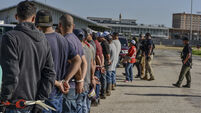HSE could learn from corporate giant with similar staff numbers
Every time you buy a Magnum ice cream or a jar of Hellman’s mayonnaise, you’re supporting Unilever’s bottom line. Every time you wash your hair in Dove shampoo or pour Domestos down the toilet, you’re keeping someone in employment in Unilever. Some of the best known Irish brands – Lyons Tea, HB ice cream – belong to Unilever.
The company describes itself as a world leader in food, home and personal care products, and most of its brands occupy what is called market leadership. And they lead the market in most of the countries of the world.
The company is not just active in more than 100 countries, it’s huge, with a worldwide turnover of just under €40 billion and more than 250 manufacturing plants around the globe. The company claims to touch the lives of two billion people every day. And there isn’t a country in the world where you can’t buy a Unilever product.
In the US, Unilever employs about 40,000 people. Across Europe, Asia, Africa and the rest of the world the company employs 120,000 people. That’s 120,000 people working in manufacturing, sales, marketing, distribution, quality control, administration and management in nearly a 100 countries.
Sounds complex, doesn’t it? All those products, all those markets, all those staff doing different and complex things. The numbers, when you look at them, are staggering and the impact the company has – and can have – on areas like the natural environment represents a hugely onerous responsibility.
And here’s the really staggering thing. In terms of the number of people employed (leaving aside the US), Unilever is the same size as the HSE.
But (and I mean no disrespect) Unilever only makes tea, ice cream and shampoo. Nobody’s life depends on their products, and even though they have managed to inspire great brand loyalty, you wouldn’t think it was the end of the world if you couldn’t buy a Magnum and had to settle for some other ice cream (although given that they own HB and Ben & Jerry’s as well, the other ice cream you buy could well be a Unilever one too).
With the same number of employees, the HSE’s turnover is slightly less than half that of Unilever. It operates in one country, not 100. Its work has an impact on the lives of each and every one of us, maybe not every day but sooner or later. And that impact, when it happens, can be profound, life-saving or life-changing. So, if it’s possible to run a company like Unilever at a profit, delivering a global reputation for quality and innovation, making a good return to shareholders, offering decent standards of employment and generally avoiding controversy, how come the HSE can’t seem to do the same?
I’m not trying to make a simplistic comparison here. I do know that the work the HSE does is far more complex and fundamental, on a day-to-day basis, than anything Unilever does. But the HSE matters to us for all sorts of reasons and it’s surely not unfair to expect that it should be capable of being examined critically and compared to similar size organisations that appear to be delivering the goods.
I was quoted recently as saying that the HSE isn’t fit for purpose. While the quote didn’t seem particularly controversial to most people I’ve met, it did cause offence to many people I respect in the HSE who felt that it was a personal attack on them.
Naturally, of course, the quotation didn’t capture exactly what I said. I was appearing with other colleagues, in both the ISPCC and Barnardos, in front of the Oireachtas Committee on Health and Children who were examining issues related to child protection.
What I actually said to the committee was this: “The time has come to examine whether the HSE is fit for purpose in terms of child protection. Issues have come to light recently suggesting it is not. I echo the comments of Mr Ashley Balbirnie (CEO of the ISPCC) when he said there are great people in the area but the leadership has been given no authority to do the job. As a result, there is a complete lack of clear national standards, the lack of a clear assessment model and no national agreement on the thresholds we as a nation want to set in terms of protecting our children. The rest of our submission makes clear there is a major gap between the lip service paid to policy and to implementation where it really matters. Statutory and non-statutory frontline services continue to struggle with inadequate resources, guidance and direction. It remains unclear, even at this stage, who carries ultimate political responsibility and accountability for vulnerable children and families… While that is going on, organisations such as Barnardos, the ISPCC and many other voluntary organisations working in the field encounter more children at risk, more families under stress and more communities coping with disadvantage. We encounter fear, hunger, lice and dirt in children and children at significant risk of neglect.”
The Ombudsman for Children, and others, have said the same thing. More to the point, the HSE itself commissioned a report last year from a leading management consultant (PA Consulting) into how they are delivering child protection services. That report was far more critical than anything I’ve said. It pointed to the lack of any link from senior management to frontline services, and to the huge variations in standards right across the service.
NO organisation, large or small, can deliver what it’s supposed to if there aren’t clear standards and if they are not being ensured by the management of the organisation. To take a trivial example, imagine what would happen to the sales of Magnum ice cream if you didn’t know what to expect in terms of taste every time you unwrapped one – or if Unilever decided to cut costs by not insisting that Magnums are kept in a fridge?
Two social workers employed by the HSE recently wrote letters to the newspapers. One was drawing attention to the many success stories in child protection, the other was saying how haunted she felt by the memory of failure in one particular tragic case. Both have a point of view that needs to be respected.
But the reality is that as it is currently structured – and this is just as true of people with disability, elderly people, and people with mental health difficulties as it is true of vulnerable children – the HSE cannot deliver the services that are urgently needed.
Unilever works, like many other multina tional companies because it has a clear understanding of its market and the capacity to be flexible in responding to its needs. I don’t suppose it’s anything like a perfect organisation, but from the top down it is focused on results. The HSE, on the other hand, finds itself focused on crisis management for far too much of the time. It desperately needs a fresh start and radical restructuring. Until that happens, the HSE won’t be truly fit for purpose.















